Hanqing Lu
National Lab of Pattern Recognition, Institute of Automation, Chinese Academy of Sciences, University of Chinese Academy of Sciences
Towards Context-Robust LLMs: A Gated Representation Fine-tuning Approach
Feb 22, 2025Abstract:Large Language Models (LLMs) enhanced with external contexts, such as through retrieval-augmented generation (RAG), often face challenges in handling imperfect evidence. They tend to over-rely on external knowledge, making them vulnerable to misleading and unhelpful contexts. To address this, we propose the concept of context-robust LLMs, which can effectively balance internal knowledge with external context, similar to human cognitive processes. Specifically, context-robust LLMs should rely on external context only when lacking internal knowledge, identify contradictions between internal and external knowledge, and disregard unhelpful contexts. To achieve this goal, we introduce Grft, a lightweight and plug-and-play gated representation fine-tuning approach. Grft consists of two key components: a gating mechanism to detect and filter problematic inputs, and low-rank representation adapters to adjust hidden representations. By training a lightweight intervention function with only 0.0004\% of model size on fewer than 200 examples, Grft can effectively adapt LLMs towards context-robust behaviors.
Towards Knowledge Checking in Retrieval-augmented Generation: A Representation Perspective
Nov 21, 2024Abstract:Retrieval-Augmented Generation (RAG) systems have shown promise in enhancing the performance of Large Language Models (LLMs). However, these systems face challenges in effectively integrating external knowledge with the LLM's internal knowledge, often leading to issues with misleading or unhelpful information. This work aims to provide a systematic study on knowledge checking in RAG systems. We conduct a comprehensive analysis of LLM representation behaviors and demonstrate the significance of using representations in knowledge checking. Motivated by the findings, we further develop representation-based classifiers for knowledge filtering. We show substantial improvements in RAG performance, even when dealing with noisy knowledge databases. Our study provides new insights into leveraging LLM representations for enhancing the reliability and effectiveness of RAG systems.
Exploring Query Understanding for Amazon Product Search
Aug 05, 2024



Abstract:Online shopping platforms, such as Amazon, offer services to billions of people worldwide. Unlike web search or other search engines, product search engines have their unique characteristics, primarily featuring short queries which are mostly a combination of product attributes and structured product search space. The uniqueness of product search underscores the crucial importance of the query understanding component. However, there are limited studies focusing on exploring this impact within real-world product search engines. In this work, we aim to bridge this gap by conducting a comprehensive study and sharing our year-long journey investigating how the query understanding service impacts Amazon Product Search. Firstly, we explore how query understanding-based ranking features influence the ranking process. Next, we delve into how the query understanding system contributes to understanding the performance of a ranking model. Building on the insights gained from our study on the evaluation of the query understanding-based ranking model, we propose a query understanding-based multi-task learning framework for ranking. We present our studies and investigations using the real-world system on Amazon Search.
Node-wise Filtering in Graph Neural Networks: A Mixture of Experts Approach
Jun 05, 2024Abstract:Graph Neural Networks (GNNs) have proven to be highly effective for node classification tasks across diverse graph structural patterns. Traditionally, GNNs employ a uniform global filter, typically a low-pass filter for homophilic graphs and a high-pass filter for heterophilic graphs. However, real-world graphs often exhibit a complex mix of homophilic and heterophilic patterns, rendering a single global filter approach suboptimal. In this work, we theoretically demonstrate that a global filter optimized for one pattern can adversely affect performance on nodes with differing patterns. To address this, we introduce a novel GNN framework Node-MoE that utilizes a mixture of experts to adaptively select the appropriate filters for different nodes. Extensive experiments demonstrate the effectiveness of Node-MoE on both homophilic and heterophilic graphs.
Towards Unified Multi-Modal Personalization: Large Vision-Language Models for Generative Recommendation and Beyond
Mar 27, 2024



Abstract:Developing a universal model that can effectively harness heterogeneous resources and respond to a wide range of personalized needs has been a longstanding community aspiration. Our daily choices, especially in domains like fashion and retail, are substantially shaped by multi-modal data, such as pictures and textual descriptions. These modalities not only offer intuitive guidance but also cater to personalized user preferences. However, the predominant personalization approaches mainly focus on the ID or text-based recommendation problem, failing to comprehend the information spanning various tasks or modalities. In this paper, our goal is to establish a Unified paradigm for Multi-modal Personalization systems (UniMP), which effectively leverages multi-modal data while eliminating the complexities associated with task- and modality-specific customization. We argue that the advancements in foundational generative modeling have provided the flexibility and effectiveness necessary to achieve the objective. In light of this, we develop a generic and extensible personalization generative framework, that can handle a wide range of personalized needs including item recommendation, product search, preference prediction, explanation generation, and further user-guided image generation. Our methodology enhances the capabilities of foundational language models for personalized tasks by seamlessly ingesting interleaved cross-modal user history information, ensuring a more precise and customized experience for users. To train and evaluate the proposed multi-modal personalized tasks, we also introduce a novel and comprehensive benchmark covering a variety of user requirements. Our experiments on the real-world benchmark showcase the model's potential, outperforming competitive methods specialized for each task.
Language Models As Semantic Indexers
Oct 11, 2023



Abstract:Semantic identifier (ID) is an important concept in information retrieval that aims to preserve the semantics of objects such as documents and items inside their IDs. Previous studies typically adopt a two-stage pipeline to learn semantic IDs by first procuring embeddings using off-the-shelf text encoders and then deriving IDs based on the embeddings. However, each step introduces potential information loss and there is usually an inherent mismatch between the distribution of embeddings within the latent space produced by text encoders and the anticipated distribution required for semantic indexing. Nevertheless, it is non-trivial to design a method that can learn the document's semantic representations and its hierarchical structure simultaneously, given that semantic IDs are discrete and sequentially structured, and the semantic supervision is deficient. In this paper, we introduce LMINDEXER, a self-supervised framework to learn semantic IDs with a generative language model. We tackle the challenge of sequential discrete ID by introducing a semantic indexer capable of generating neural sequential discrete representations with progressive training and contrastive learning. In response to the semantic supervision deficiency, we propose to train the model with a self-supervised document reconstruction objective. The learned semantic indexer can facilitate various downstream tasks, such as recommendation and retrieval. We conduct experiments on three tasks including recommendation, product search, and document retrieval on five datasets from various domains, where LMINDEXER outperforms competitive baselines significantly and consistently.
Amazon-M2: A Multilingual Multi-locale Shopping Session Dataset for Recommendation and Text Generation
Jul 19, 2023Abstract:Modeling customer shopping intentions is a crucial task for e-commerce, as it directly impacts user experience and engagement. Thus, accurately understanding customer preferences is essential for providing personalized recommendations. Session-based recommendation, which utilizes customer session data to predict their next interaction, has become increasingly popular. However, existing session datasets have limitations in terms of item attributes, user diversity, and dataset scale. As a result, they cannot comprehensively capture the spectrum of user behaviors and preferences. To bridge this gap, we present the Amazon Multilingual Multi-locale Shopping Session Dataset, namely Amazon-M2. It is the first multilingual dataset consisting of millions of user sessions from six different locales, where the major languages of products are English, German, Japanese, French, Italian, and Spanish. Remarkably, the dataset can help us enhance personalization and understanding of user preferences, which can benefit various existing tasks as well as enable new tasks. To test the potential of the dataset, we introduce three tasks in this work: (1) next-product recommendation, (2) next-product recommendation with domain shifts, and (3) next-product title generation. With the above tasks, we benchmark a range of algorithms on our proposed dataset, drawing new insights for further research and practice. In addition, based on the proposed dataset and tasks, we hosted a competition in the KDD CUP 2023 and have attracted thousands of users and submissions. The winning solutions and the associated workshop can be accessed at our website https://kddcup23.github.io/.
Multilingual Knowledge Graph Completion with Self-Supervised Adaptive Graph Alignment
Mar 28, 2022



Abstract:Predicting missing facts in a knowledge graph (KG) is crucial as modern KGs are far from complete. Due to labor-intensive human labeling, this phenomenon deteriorates when handling knowledge represented in various languages. In this paper, we explore multilingual KG completion, which leverages limited seed alignment as a bridge, to embrace the collective knowledge from multiple languages. However, language alignment used in prior works is still not fully exploited: (1) alignment pairs are treated equally to maximally push parallel entities to be close, which ignores KG capacity inconsistency; (2) seed alignment is scarce and new alignment identification is usually in a noisily unsupervised manner. To tackle these issues, we propose a novel self-supervised adaptive graph alignment (SS-AGA) method. Specifically, SS-AGA fuses all KGs as a whole graph by regarding alignment as a new edge type. As such, information propagation and noise influence across KGs can be adaptively controlled via relation-aware attention weights. Meanwhile, SS-AGA features a new pair generator that dynamically captures potential alignment pairs in a self-supervised paradigm. Extensive experiments on both the public multilingual DBPedia KG and newly-created industrial multilingual E-commerce KG empirically demonstrate the effectiveness of SS-AG
QUEACO: Borrowing Treasures from Weakly-labeled Behavior Data for Query Attribute Value Extraction
Sep 05, 2021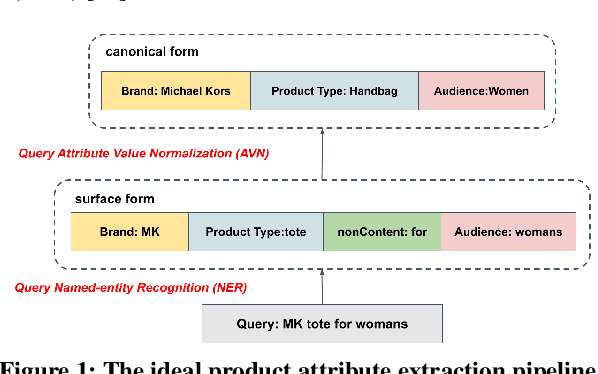


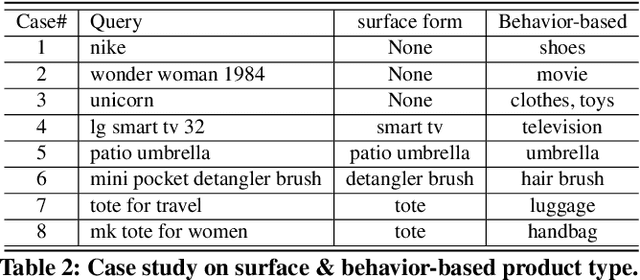
Abstract:We study the problem of query attribute value extraction, which aims to identify named entities from user queries as diverse surface form attribute values and afterward transform them into formally canonical forms. Such a problem consists of two phases: {named entity recognition (NER)} and {attribute value normalization (AVN)}. However, existing works only focus on the NER phase but neglect equally important AVN. To bridge this gap, this paper proposes a unified query attribute value extraction system in e-commerce search named QUEACO, which involves both two phases. Moreover, by leveraging large-scale weakly-labeled behavior data, we further improve the extraction performance with less supervision cost. Specifically, for the NER phase, QUEACO adopts a novel teacher-student network, where a teacher network that is trained on the strongly-labeled data generates pseudo-labels to refine the weakly-labeled data for training a student network. Meanwhile, the teacher network can be dynamically adapted by the feedback of the student's performance on strongly-labeled data to maximally denoise the noisy supervisions from the weak labels. For the AVN phase, we also leverage the weakly-labeled query-to-attribute behavior data to normalize surface form attribute values from queries into canonical forms from products. Extensive experiments on a real-world large-scale E-commerce dataset demonstrate the effectiveness of QUEACO.
* The 30th ACM International Conference on Information and Knowledge Management (CIKM 2021, Applied Research Track)
OPT: Omni-Perception Pre-Trainer for Cross-Modal Understanding and Generation
Jul 06, 2021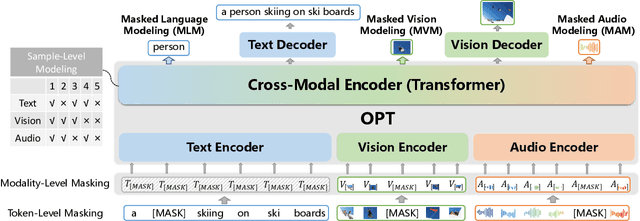
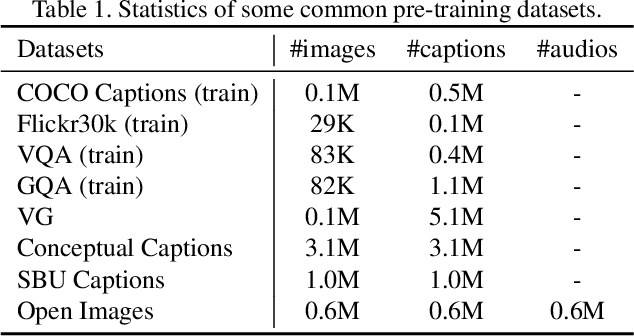
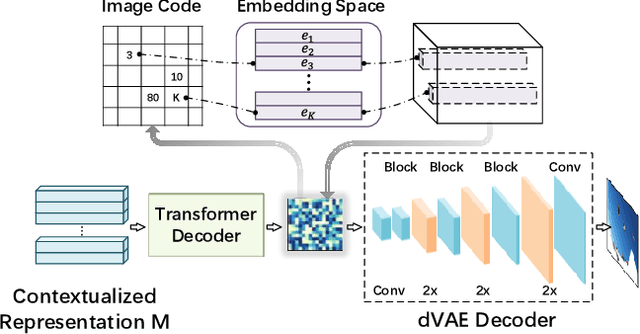
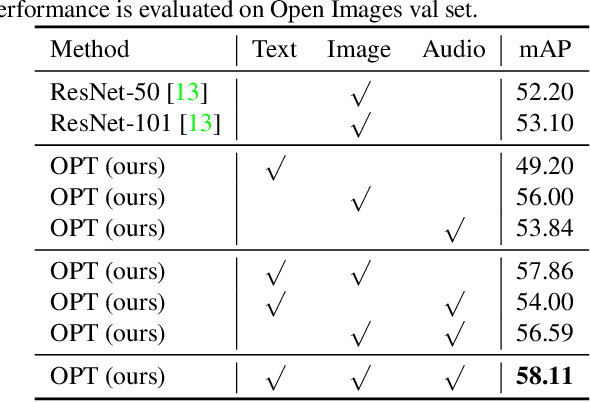
Abstract:In this paper, we propose an Omni-perception Pre-Trainer (OPT) for cross-modal understanding and generation, by jointly modeling visual, text and audio resources. OPT is constructed in an encoder-decoder framework, including three single-modal encoders to generate token-based embeddings for each modality, a cross-modal encoder to encode the correlations among the three modalities, and two cross-modal decoders to generate text and image respectively. For the OPT's pre-training, we design a multi-task pretext learning scheme to model multi-modal resources from three different data granularities, \ie, token-, modality-, and sample-level modeling, through which OPT learns to align and translate among different modalities. The pre-training task is carried out on a large amount of image-text-audio triplets from Open Images. Experimental results show that OPT can learn strong image-text-audio multi-modal representations and achieve promising results on a variety of cross-modal understanding and generation tasks.
 Add to Chrome
Add to Chrome Add to Firefox
Add to Firefox Add to Edge
Add to Edge